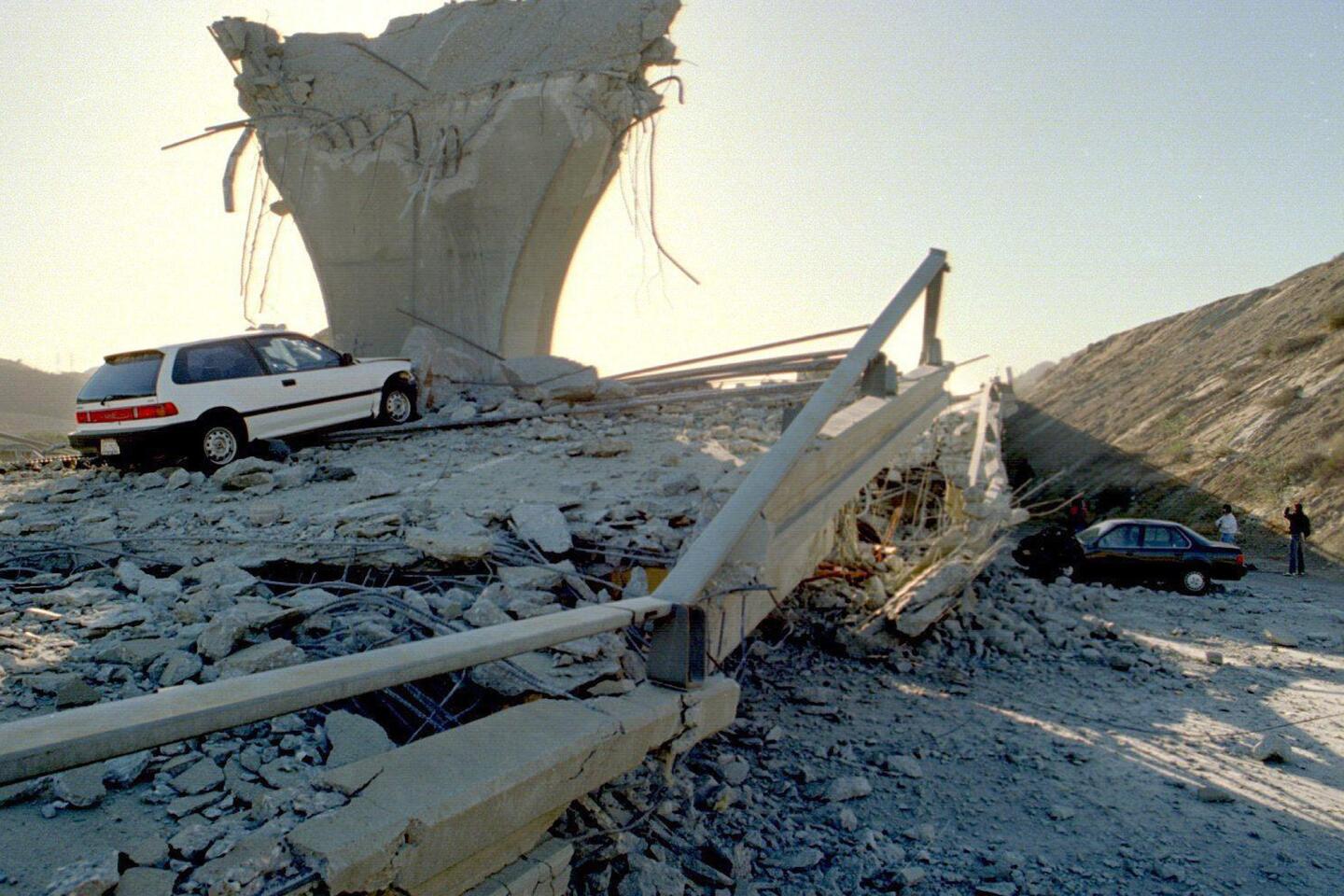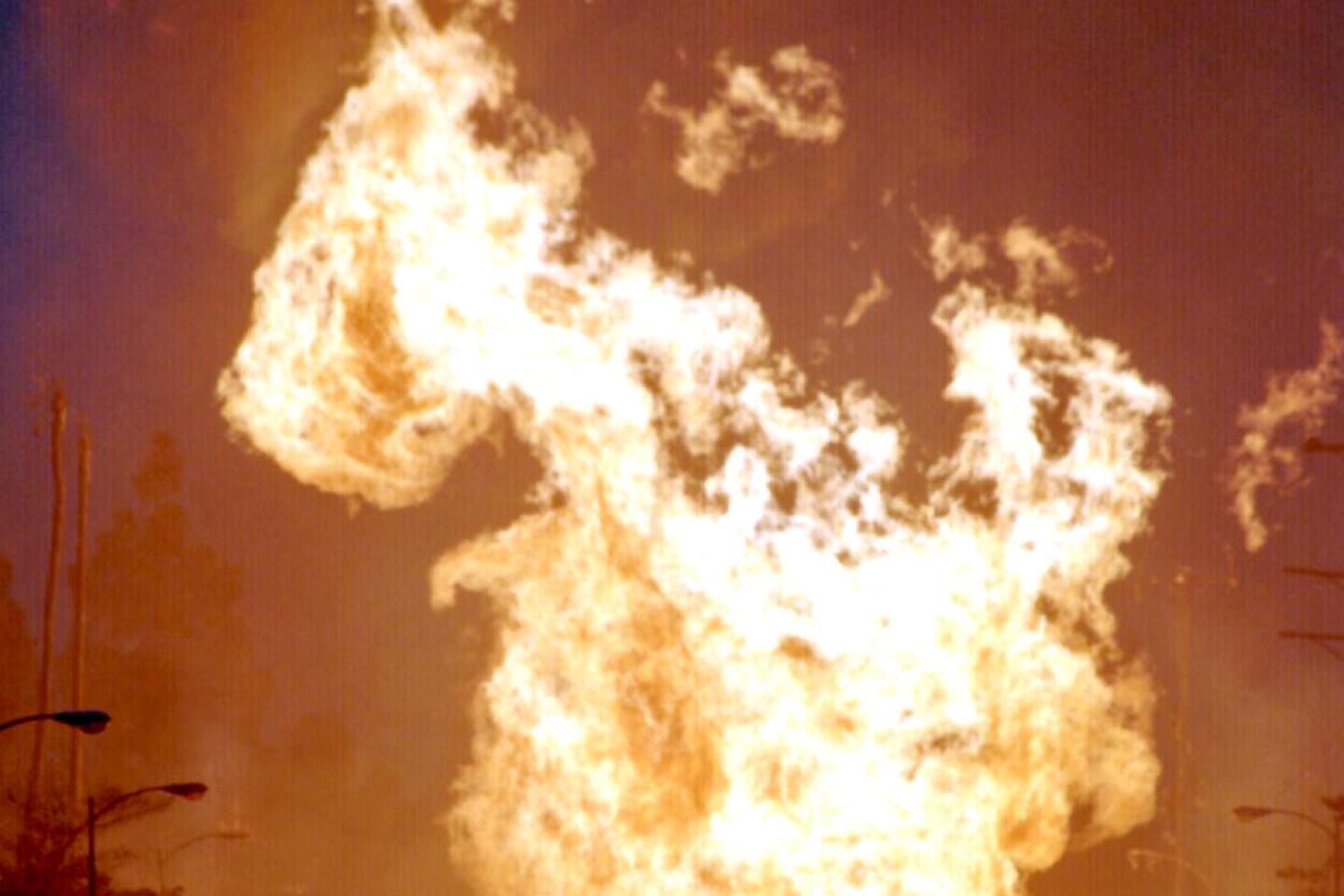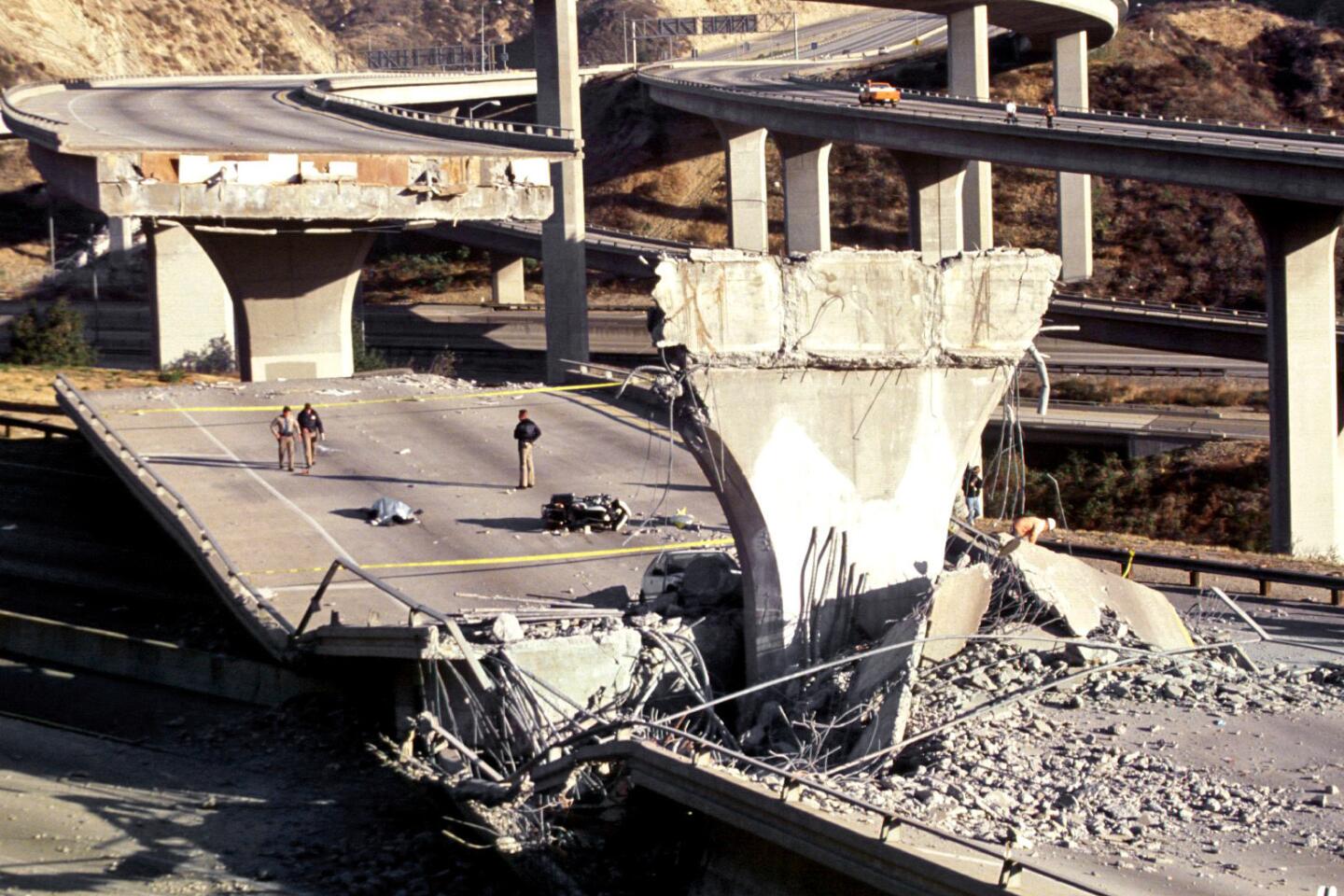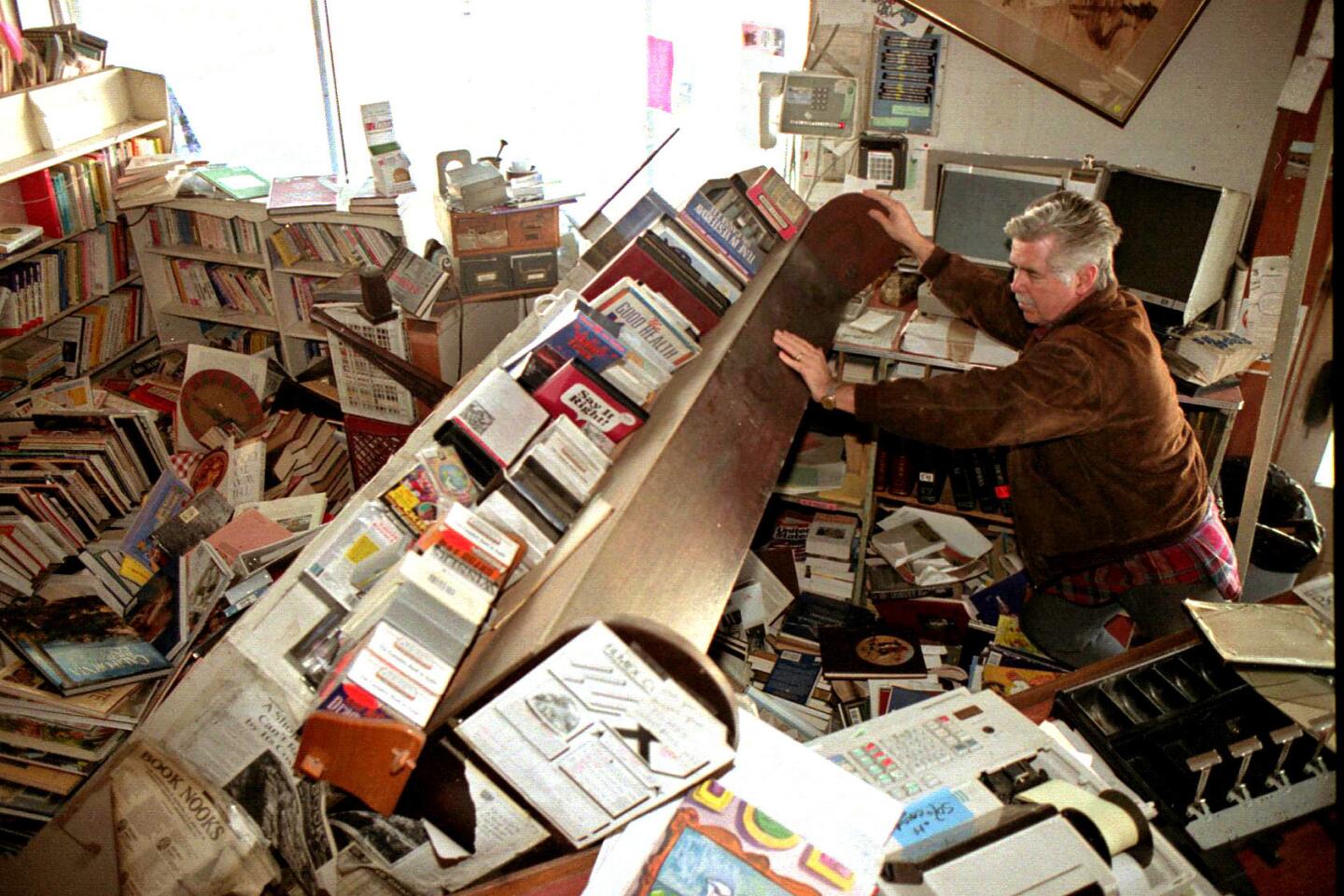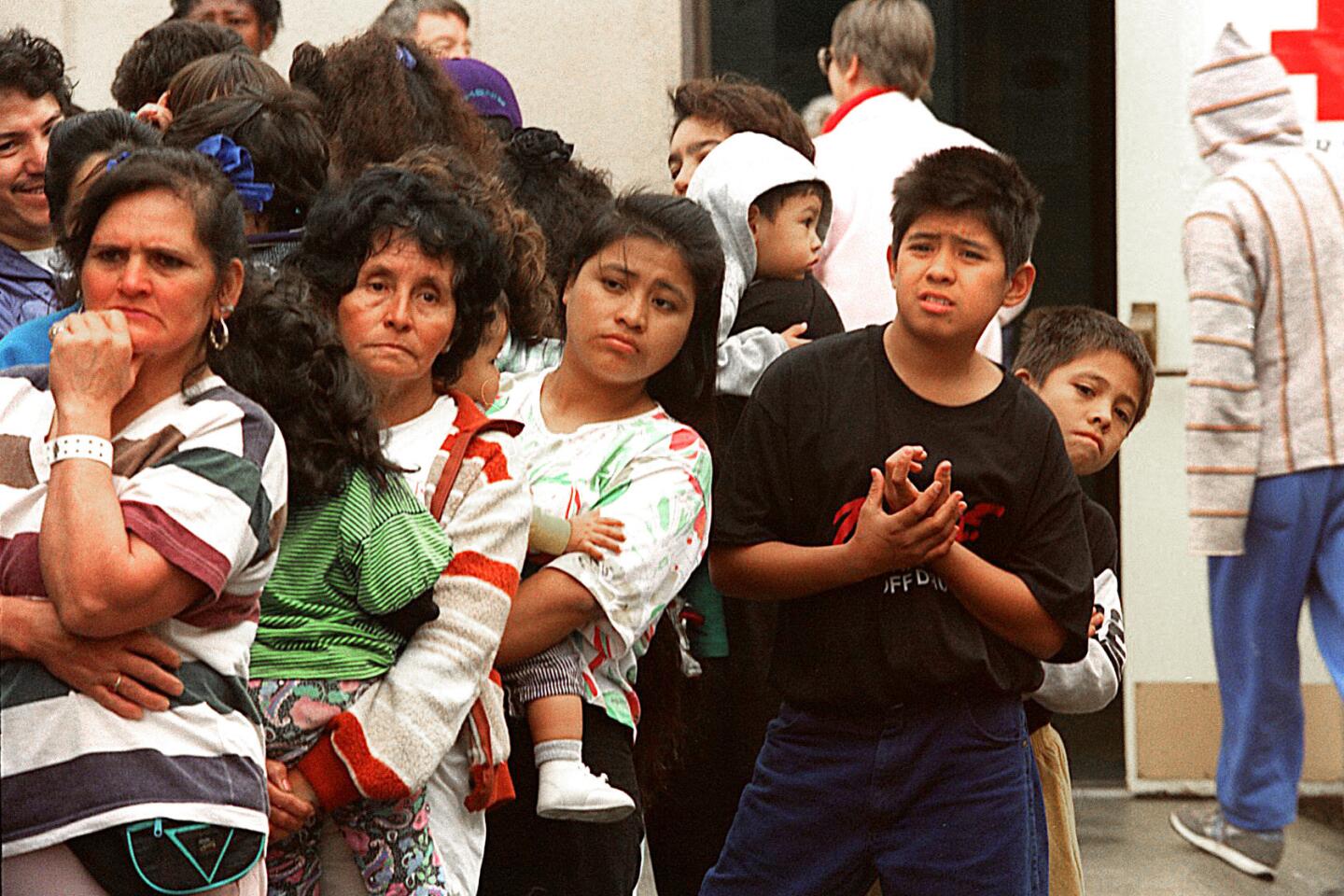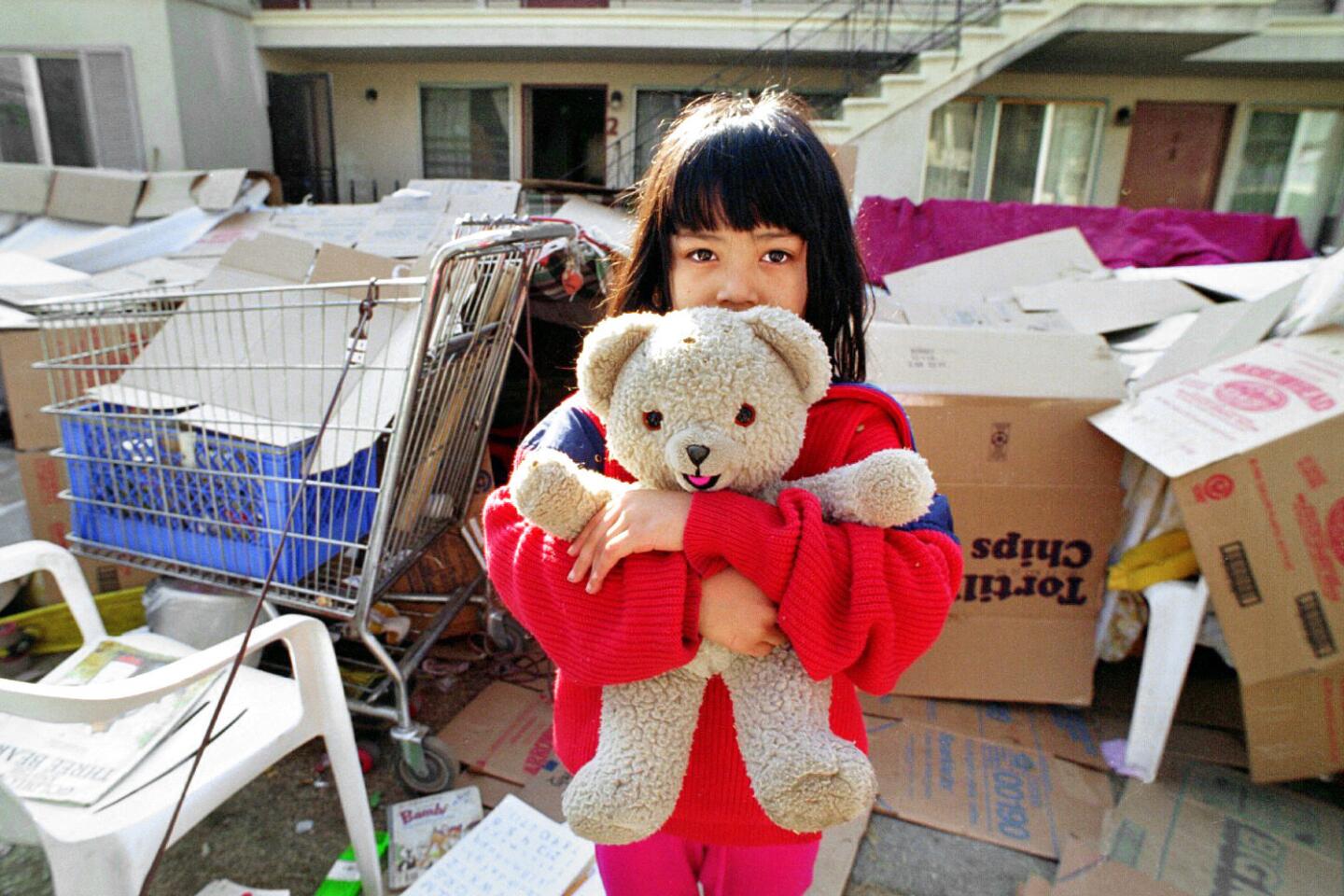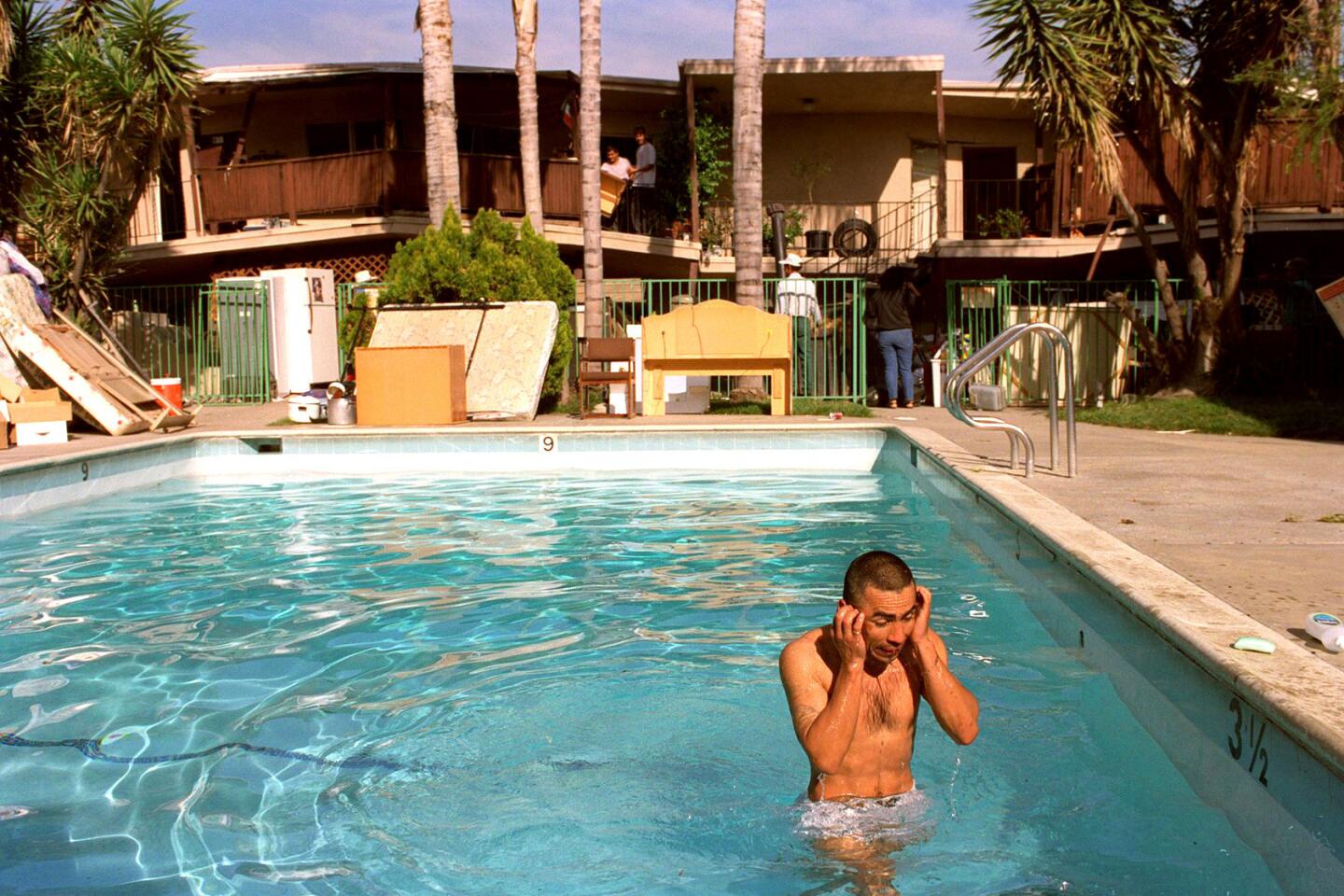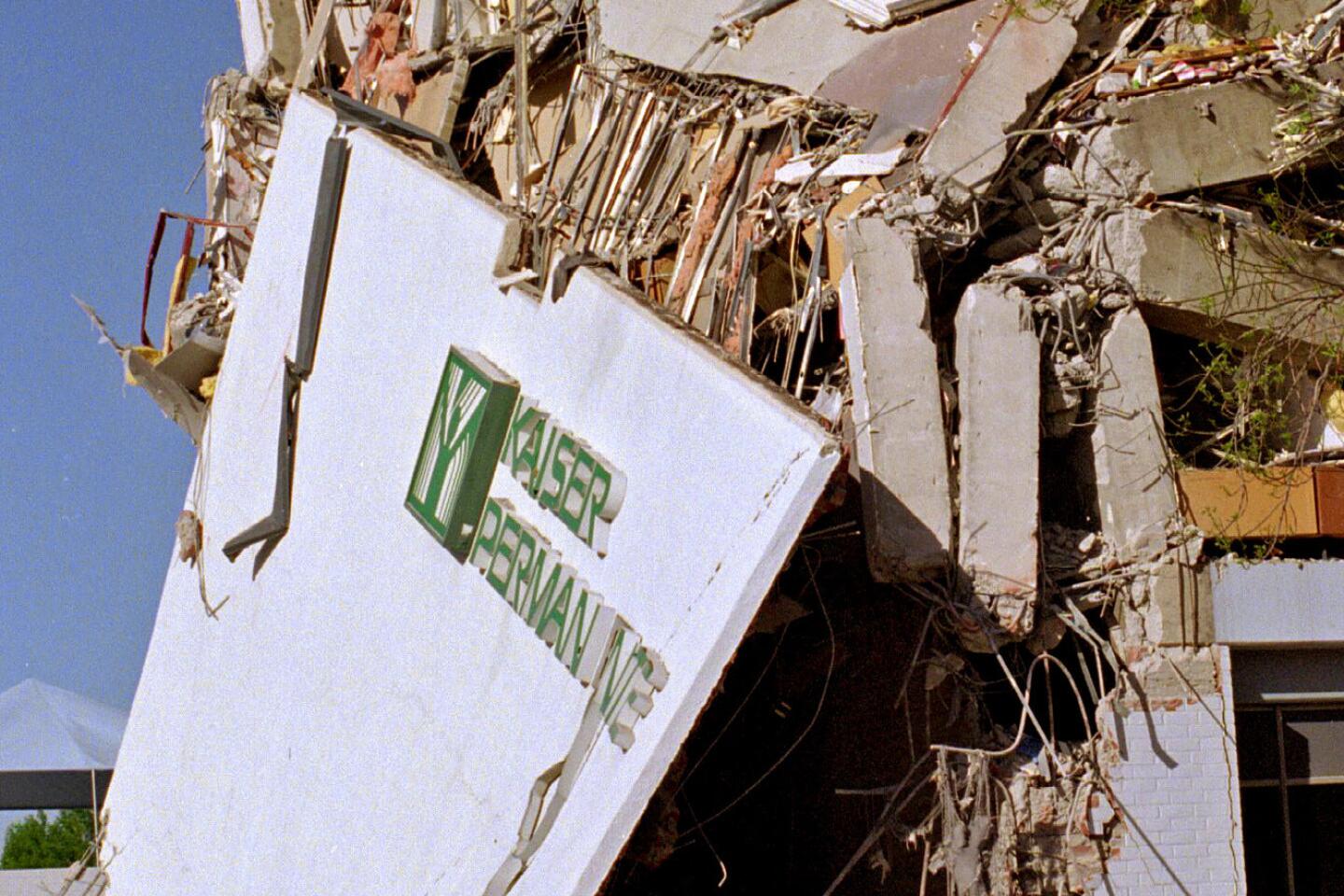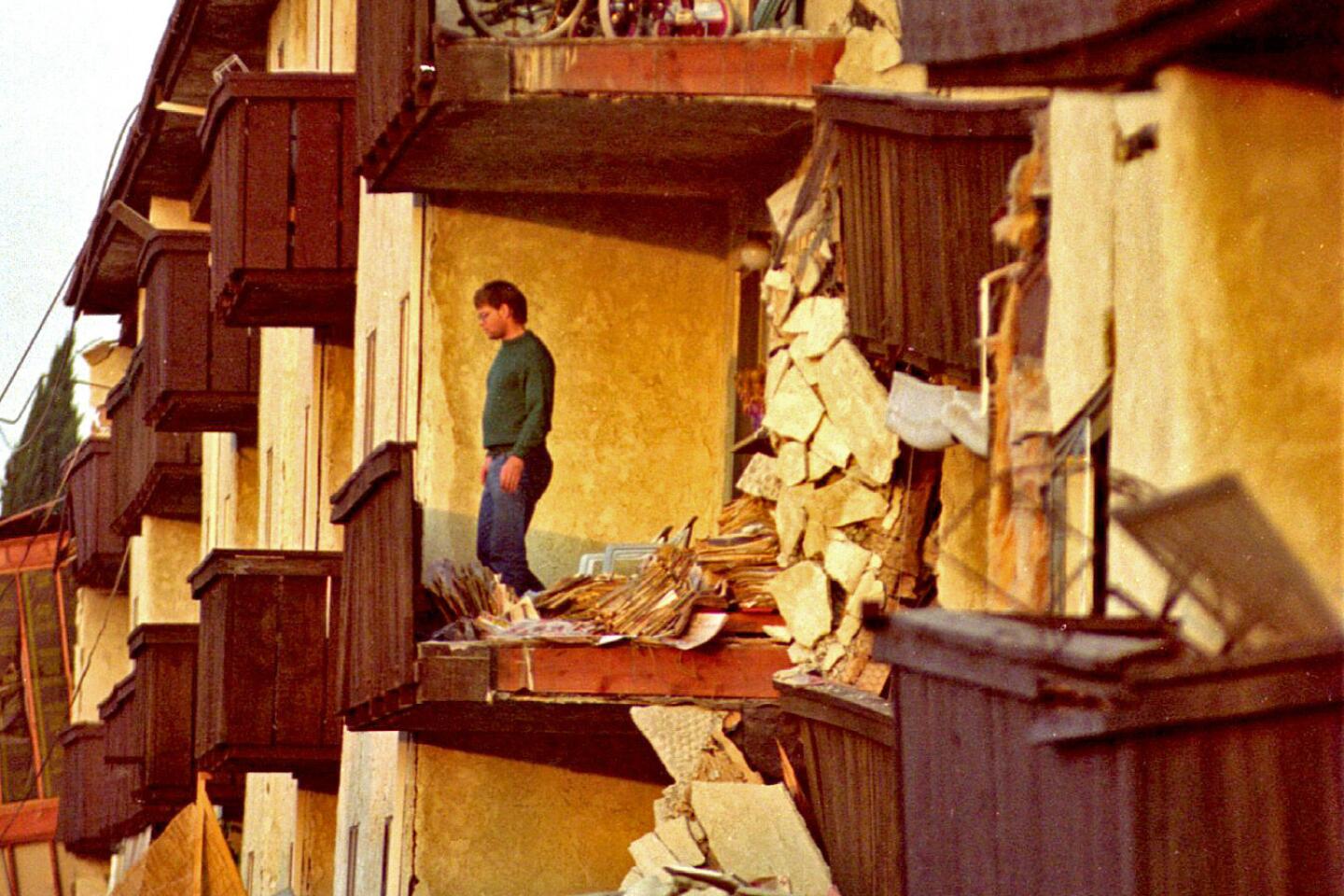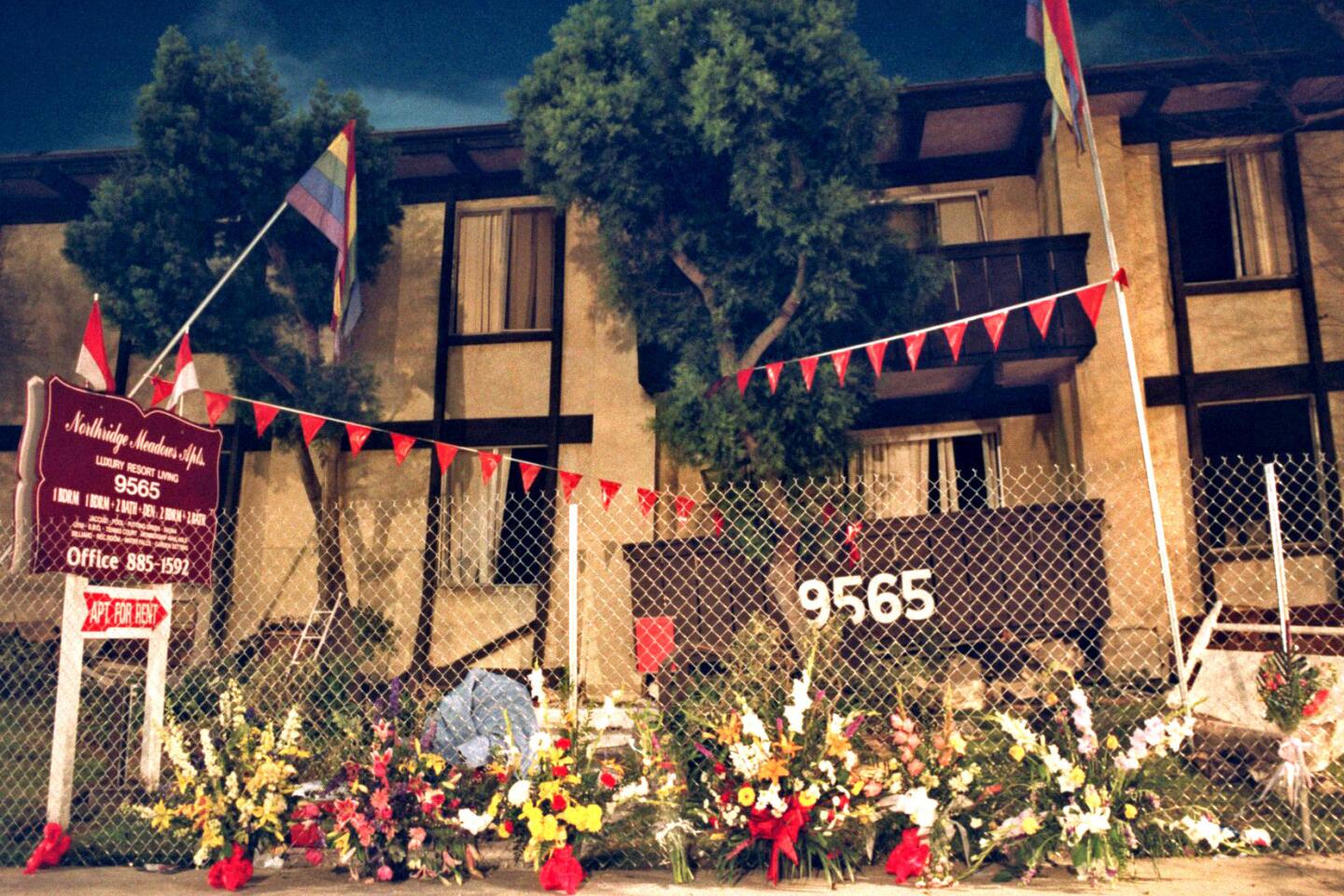A Rush of Fear, and Even the Lucky Are Left Shaken
- Share via
Curled up like a frightened baby, Elsie Thull lay on the floor of an elevator in the 21-story New Otani Hotel in Downtown Los Angeles and prayed. Everything was black, except for the incessant blinking of the floor numbers, and the contraption was rattling in the throes of an earthquake that was about to bring the region to its knees.
She was trapped.
She fumbled for the emergency telephone. Hotel officials put her husband, Ted, on the line. In quiet tones, the retired airline pilot tried to calm his wife, hoping to reassure her, failing miserably. “Ted!” she cried. “Get me out of here! Get me out of here!”
Elsie Thull’s terror--10 seconds of sheer panic shared by millions--stretched to nearly an hour before help arrived. And the 56-year-old Ohio woman, who had escaped the freezing cold that gripped much of the nation for a weekend trip to Southern California’s famed winter warmth, was left with an impression unlikely to change.
“I don’t like Los Angeles,” she declared once she was out.
There is a joke going around the region these days, ever since the wildfires of this past fall: Los Angeles has four seasons--fire, flood, earthquake and drought. It is black humor, but on Monday it wasn’t so funny anymore. People are tired, here in sunny Southern California. Nature has provided a land of great beauty but a land that can be cruel as well.
Nerves are frayed and jangled. Residents are frightened of the roar of an Earth that shifts without warning underneath them and of things that crash in the night in houses far removed from Ground Zero. People are worried about what is coming next. And Monday’s 6.6 shaker, which leveled freeways, touched off at least 30 fires and claimed more than 30 lives, wasn’t even the Big One. For many, that is the scariest notion of all.
Los Angeles County Tax Assessor Kenneth Hahn told a radio announcer, only half in jest, that he is now waiting for “a plague of locusts.” Said Gov. Pete Wilson, looking down on the devastation from a helicopter: “You begin to wonder how much Angelenos are expected to take.”
“I just don’t know if it’s worth it anymore,” sighed David Whitener, a 30-year-old court reporter as he tried, in vain, to buy coffee at a McDonald’s on La Brea Avenue that had no hot food and no hot water. “I just don’t know if it’s worth it, with the economic situation here and the fires and earthquakes, and. . . ,” Whitener paused for a moment. “What else bad happens here?”
“Riots,” answered his companion, Jimmy Grape.
“Yes, riots,” Whitener repeated wearily. “On the news, they’ve been telling us that this will be a test of our preparedness. Is this a precursor to the Big One that will come any minute?”
Radios crackled all day, the sign of a true disaster. There were pronouncements from politicians, advisories from the agencies that bring the city its water and power and gas, declarations of disaster zones and the like. There was talk from seismologists, news conferences laced with all-too-familiar earthquake jargon of “transportation arteries” and “crumbling infrastructures” and “damage assessment surveys.”
This took care of the immediate need, the physical damage. Caring for the psychic damage will be far more complex.
Earthquakes are different from wildfires and floods. Most people watched those catastrophes from a distance, a drama that unfolded on television. But almost everyone who lives in Southern California felt Monday’s mighty quake. Nobody could be a bystander.
“No one,” said psychologist Robert T. Scott, a consultant for the American Red Cross, “could walk away from this one saying, ‘No, that didn’t affect me.’ ”
Earthquakes, Scott noted, cannot be predicted. They are not a function of the weather. Nobody knows they are coming. This “sends a scary message through our primordial survival mechanism. We get jolted out of bed and everything goes into high alert. Flashing lights, crashing glass. It really charges us up. That is why earthquakes carry such emotional power.”
Home--the last safe place in a city that is scary enough already--no longer feels safe.
So people seek safety, and comfort, in one another. In the span of 10 seconds Monday morning, this city of cars became a pedestrian town. In the dark before dawn, people were out in the streets, checking on neighbors, swapping stories, simply being together. In a metropolis as diverse as this one, with its recent history of racial tensions, some found a blessing in that.
“I think it unites us as people,” said Linda Toliver, owner of a neon shop in Hollywood that suffered little damage. “We’re not all these differences anymore. All of a sudden, we’re all affected. . . .”
In a place where so many people come from someplace else, inevitably there was talk of going back home. Sometimes such comments are flippant. Not this time. Many of these transplants sounded serious, motivated by real fear and a longing to be with the people most important in life: close family and good friends.
Salina Sordrager is a native of Holland, now living in Hollywood and looking for a job in interior design. “Oh, God, I don’t want to be here,” she whispered to her boyfriend as they huddled in the doorway of his rattling North Hollywood apartment.
Later, after a telephone call to her parents and brother, she said what was really going through her mind: “I’ve got to get back to Europe. I don’t want to be here when the Big One hits.”
On Melrose Avenue, a man stumbled into the tony Ciao Bella eatery shortly after noon, only to be told the place was closed for lack of electricity and water. “I’m from New York and I’m going back,” he declared.
Another former New Yorker, Diane Kelly of Van Nuys, is also ready to go. “Everything was flying all over,” she said. “I felt glass on top of me. I grabbed my daughter, Amber, and I said, ‘Dear God let us live through this and we’re going back to New York.’ ”
As he waited in line for a Mid-City Vons supermarket to open Monday morning, Henry Turnispeed swore this was the last quake he would live through in the West. His brand-new television set--price tag $800--had flown off its stand and didn’t work. For him, that was the last straw.
“Soon as I money up, I’m gone,” he said. “I think I’m going back to Chicago. It’s much easier for me to deal with below-zero weather than looking up and seeing a television dancing on the ceiling.”
People in Southern California often tell friends in other places that they get used to earthquakes. It’s a white lie. No one ever does.
Dale Huckfelt can testify to that. He owns a furniture store in historic uptown Whittier, where a 5.9 temblor cut a massive swath of destruction in 1987, leveling dozens of buildings. Right after the Earth shifted Monday, Huckfelt jumped into his car and drove to his shop. It had been spared.
“You can’t imagine the destruction that was here in 1987,” he said. “I just prayed it wouldn’t happen again.”
For Christina Nichols of Granada Hills, earthquake memories are far more haunting. Her mother was killed in the 1971 Sylmar quake. Nichols was asleep on a sofa when Monday’s quake jolted her awake. She watched in horror as the ceiling buckled above her and her belongings flew about the house. Her heart raced, and all she could think about was her mother.
“It freaks you out, because you think: Am I going to die the way my mother did?” she said. “Am I going to leave kids behind too?”
The Northridge quake--as it was dubbed Monday--will take its own place in local history, beside Sierra Madre and Whittier and Sylmar. And for the rest of their lives, people like Ida Vasquez will be telling stories about it.
“I was going 40 miles an hour and all of a sudden I couldn’t steer my car anymore,” said Vasquez, who had just dropped her son off at his job in Oxnard. “I thought I had a flat, but then I saw the lights from Point Mugu going off and on, and the radio started getting staticky. . . . I started to say the ‘Our Father’ because I thought it as the end of the world. I thought it was a nuclear bomb.”
By nightfall Monday, that kind of initial panic seemed to give way to a feeling of weariness. Aftershocks continued to roll through the region--a phenomenon seismologists say will continue for several weeks, albeit with decreasing frequency. Fires continued. Residents began to realize that, with several crucial freeways severely damaged, getting around will be difficult for months.
Southern California, many said, has suffered more than its fair share.
“There’s never a moment of rest,” exclaimed one Altadena homeowner, whose neighborhood was burned out in the fires. “Can’t I just catch up with my life?”
More to Read
Sign up for Essential California
The most important California stories and recommendations in your inbox every morning.
You may occasionally receive promotional content from the Los Angeles Times.
